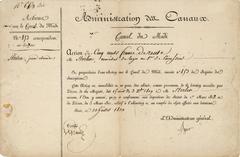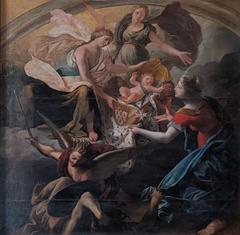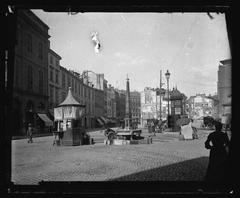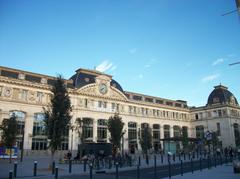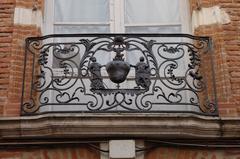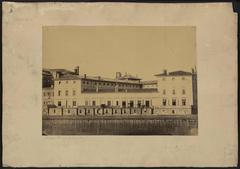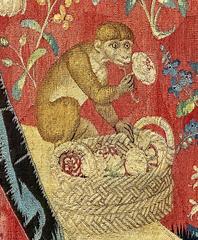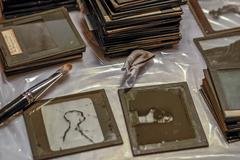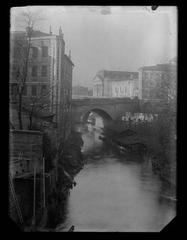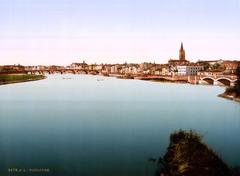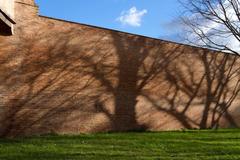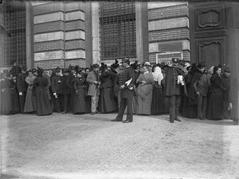Maison En Terre Cuite De Virebent: Visiting Hours, Tickets, and Comprehensive Guide to Rue des Marchands – Toulouse Historical Sites
Date: 14/06/2025
Introduction
The Maison En Terre Cuite De Virebent, nestled in the heart of Toulouse’s historic center, stands as a remarkable testament to 19th-century architectural innovation and the city’s enduring artisanal traditions. Renowned for its striking terracotta façade adorned with twelve caryatids, this unique townhouse reflects not only the creative genius of the Virebent family but also embodies Toulouse’s evolution from its Roman and Renaissance foundations to a modern urban landscape. Whether you’re an architecture aficionado, a history lover, or a cultural traveler, this comprehensive guide will help you discover the Maison’s historical significance, architectural highlights, visiting hours, ticketing policies, accessibility details, and tips for maximizing your visit. For deeper insights, refer to official tourism and heritage resources. (Lonely Planet, Musée du Patrimoine, Monumentum)
Table of Contents
- Discovering the Maison: A Toulouse Architectural Gem
- Historical and Architectural Context
- The Virebent Dynasty and Terracotta Innovation
- Artistic and Cultural Significance
- Visiting Information: Hours, Tickets, and Accessibility
- Planning Your Visit: Practical Tips and Nearby Attractions
- The Virebent Legacy: Urban and Cultural Impact
- Frequently Asked Questions (FAQ)
- Conclusion: Preserving and Experiencing Toulouse’s Architectural Heritage
- References & Official Resources
Discovering the Maison: A Toulouse Architectural Gem
Located at 28 rue des Marchands, the Maison En Terre Cuite De Virebent is one of the city’s most distinctive historical sites. Its twelve terracotta caryatids—female figures supporting the balcony—are a unique feature that showcases the marriage of artistic vision and technical mastery. The building is a highlight of Toulouse’s historic center, drawing visitors eager to experience its unique blend of heritage and innovation. (Lonely Planet)
Historical and Architectural Context
Constructed in the early 1840s, the Maison En Terre Cuite De Virebent was designed by Auguste Virebent, an influential architect and industrialist. The building exemplifies the expansion and modernization of Toulouse in the 19th century, when the city embraced broader streets and decorative facades while maintaining its distinctive regional identity.
The Maison is characterized by:
- Three horizontal registers marked by terracotta friezes and cornices.
- Arcaded ground floor with commercial spaces.
- Two “étages nobles” (main residential stories) topped by an attic level.
- Continuous bossage brickwork alternating in tone, creating visual depth.
- Terracotta caryatids on the first floor, inspired by Renaissance and classical precedents.
The use of terracotta—produced at the Virebent family’s brickworks—became a signature element not only for this building but also for the wider cityscape, giving Toulouse its enduring moniker, “La Ville Rose.” (Monumentum)
The Virebent Dynasty and Terracotta Innovation
Auguste Virebent: Pioneer of Terracotta Architecture
Auguste Virebent (1792–1857) revolutionized architectural decoration by perfecting the mass production of terracotta elements, making ornate ornamentation more accessible and affordable. His patented “plinthotomie” technique allowed for rapid creation of detailed, durable pieces—a breakthrough that transformed both public and private architecture in Toulouse. (Lonely Planet)
Family Legacy
The Virebent family, including Jacques-Pascal and Gaston Virebent, established a renowned brickworks in Launaguet. Their terracotta elements—caryatids, capitals, friezes, and more—adorn many of Toulouse’s finest buildings. The Maison En Terre Cuite De Virebent is their flagship achievement, but their influence can be seen throughout the city. (La Dépêche, Virebent Heritage)
Artistic and Cultural Significance
Caryatids and Decorative Program
The twelve terracotta caryatids are inspired by Jean Goujon’s Renaissance sculptures, blending neoclassical and local artistic traditions. Detailed pilasters, heraldic motifs, hunting scenes, allegorical figures, and a dentilated crest at the roofline enrich the façade’s visual narrative. These elements highlight the technical prowess and creative ambition that set the Maison apart from neighboring buildings.
Terracotta’s Role in Toulouse’s Identity
The Virebents’ work democratized urban beauty, as terracotta became a hallmark of Toulouse’s architecture. Their accessible, durable decorative elements contributed to the city’s harmonious pink and red tones, reinforcing its unique regional character. (Musée du Patrimoine)
Visiting Information: Hours, Tickets, and Accessibility
Hours and Tickets
- Exterior Viewing: The façade is visible at all times from the street; no ticket is required.
- Interior Access: The building is private, and interior access is not permitted.
- Guided Tours: Some city walking tours include the Maison as a highlight. Check with the Toulouse Tourist Office for updated offerings.
Accessibility
- The site is located in a pedestrian-friendly zone; nearby streets are paved and generally accessible.
- The exterior is viewable at street level; some uneven surfaces may be present due to the historic setting.
Planning Your Visit: Practical Tips and Nearby Attractions
Getting There
- By Metro: Capitole station (Line A) is a 5-minute walk away.
- By Bus: Multiple lines serve the area.
- By Car: Limited parking; use nearby public car parks at Place du Capitole or Victor Hugo.
Best Time for Viewing and Photography
- Early morning or late afternoon light enhances the terracotta hues and decorative details.
- Daytime visits are ideal for photography; bring a zoom or high-resolution camera for close-up shots.
Nearby Amenities
- Numerous hotels, restaurants, and cafés are located within walking distance.
- Tourist information is available at Donjon du Capitole.
Nearby Attractions
Combine your visit with:
- Musée Paul-Dupuy
- Musée Saint-Raymond
- Musée des Augustins
- Hôtel d’Assézat – Fondation Bemberg
- Musée du Vieux Toulouse
The Virebent Legacy: Urban and Cultural Impact
The Maison En Terre Cuite De Virebent is more than a beautiful façade; it’s an emblem of Toulouse’s transformation and the democratization of urban ornamentation. The Virebent family’s innovations in terracotta production fueled local economic growth, supported artisans, and left an indelible mark on the city’s architectural identity.
Conservation efforts, including the preservation of original molds and the advocacy of heritage groups, ensure that this legacy remains vibrant and accessible. The Maison continues to inspire contemporary artists, architects, and historians, serving as a living bridge between Toulouse’s past and present. (Les Amis de Virebent)
Frequently Asked Questions (FAQ)
Q: Can I visit the interior of the Maison?
A: No, the building is privately owned and not open to the public. The façade can be admired from the street at any time.
Q: Are guided tours available?
A: Some city walking tours include the Maison; check with the Toulouse Tourist Office for details.
Q: Is the site accessible for visitors with disabilities?
A: The surrounding area is generally accessible, though some uneven surfaces may exist due to the historic district.
Q: Is there an entrance fee?
A: No; viewing the exterior is free.
Q: What are the best nearby attractions?
A: Major museums, Place du Capitole, and other Virebent-adorned buildings are all within walking distance.
Conclusion: Preserving and Experiencing Toulouse’s Architectural Heritage
The Maison En Terre Cuite De Virebent is a singular highlight of Toulouse’s architectural heritage—a testament to the city’s artistic innovation and the transformative legacy of the Virebent family. While interior access is not available, its façade offers a wealth of visual and historical interest, making it an essential stop for anyone exploring Toulouse’s historic center. By planning your visit using this guide, you’ll experience the best of Toulouse’s rich architectural tradition and living history.
For more information, download the Audiala app, follow us on social media, and explore our other guides to Toulouse’s most fascinating historical sites.
References & Official Resources
- Lonely Planet: Maison En Terre Cuite De Virebent
- Monumentum: Maison En Terre Cuite De Virebent
- Musée du Patrimoine
- Virebent Heritage
- La Dépêche: Heritage of the Virebent family
- Les Amis de Virebent
- POP: Plateforme ouverte du patrimoine
- Wikimedia Commons Photo Gallery
Experience the spirit of “La Ville Rose” and the enduring artistry of the Virebents—plan your visit and discover Toulouse’s most captivating architectural legacy.

